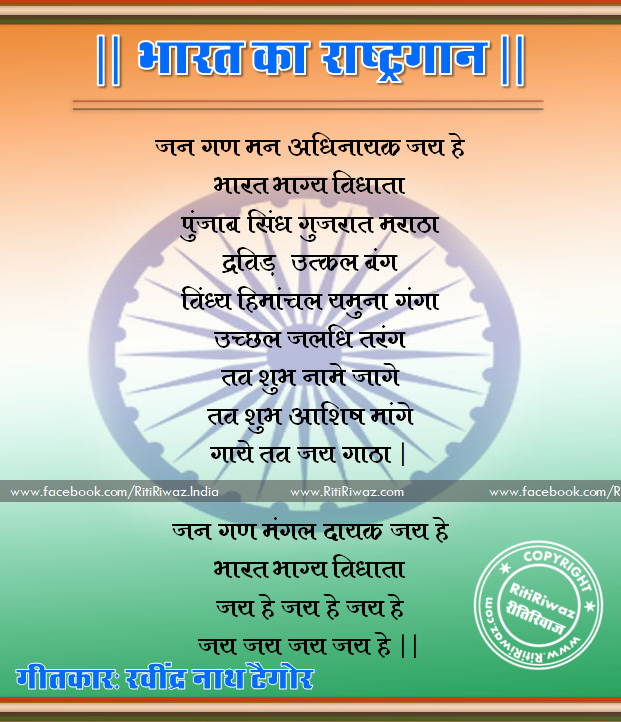National Anthem Of India | Jana Gana Mana

The song “Jana Gana Mana“, composed by Rabindranath Tagore, was adopted by the Constituent Assembly as the national anthem of India on 24 January 1950. It was first sung on 27 December 1911 at the Calcutta Session of the Indian National Congress. The complete song consists of five stanzas.
The First stanza consists of the full version of the National Anthem. The playing time of the full version of the national anthem is approximately 52 seconds. A short version consisting of the first and last lines of the stanza (playing time approximately 20 seconds) is also played on certain occasions. It reads:
| Jana-gana-mana-adhinayaka, jaya he Bharata-bhagya-vidhata. Punjaba-Sindhu-Gujarata-Maratha Dravida-Utkala-Banga Vindhya-Himachala-Yamuna-Ganga Uchchala-Jaladhi-taranga.Tava shubha name jage, Tava shubha asisa mage, Gahe tava jaya gatha,Jana-gana-mangala-dayaka jaya he Bharata-bhagya-vidhata. Jaya he, jaya he, jaya he, Jaya, jaya, jaya, jaya he! |
Suggested Read: National Symbols Of India
English Translation of the National Anthem – Jana Gana Mana
| Thou art the ruler of the minds of all people, The dispenser of India’s destiny. Thy name rouses the hearts of Punjab, Sind, Gujarat and Maratha, Of the Dravida and Orissa and Bengal; It echoes in the hills of the Vindyas and Himalayas, Mingles in the music of Jamuna and Ganges and is Chanted by the waves of the Indian Sea. They pray for thy blessings and sing thy praise. The saving of all people waits in thy hand, Thou dispenser of India’s destiny. Victory, victory, victory to thee. |
History
The song was originally composed in Bengali as Bharoto Bhagyo Bidhata by the poet Rabindranath Tagore. The first stanza of this song was adopted as Nation Anthem by the Constituent Assembly of India.
National Anthem in Bengali, Hindi, and English

The poem was first published in 1905 under the name Bharat Bhagya Bidhata in Tattwabodhini Patrika which was an Adi Brahmo Samaj journal. It was first sung at the session of the Indian National Congress in 1911 at Calcutta.
Suggested Read: National Flag Of India
In 1912 Sarala Devi Chowdhurani, Tagore’s niece performed this song with school students. Outside Calcutta, it was first sung by Rabindranath Tagore himself in Besant Theosophical College, which was widely accepted and enthralled by the students, and Tagore was requested to create an English version of this song and was adopted as college prayer and sung even till today.
The song was also sung in the movie Hamrahi, it also became the official song of The Doon School, Dehradun even before it became the national anthem of India. On the Occasion of India’s freedom in 1947 the song Jana Gana Mana was sung and was accepted as a country’s national anthem.
Code Of Conduct
The National Anthem of India is sung on various occasions in India, and special instruction has been issued regarding the correct version and code of conduct.
Whenever the national anthem is played the audience should stand to add dignity to the anthem. However, when it is played as a part of the film, it is not needed for the audience to stand as this would cause disorder and confusion rather than adding dignity to the Anthem.
There should be no dramatization of the Nation Anthem and should not be included in a variety of shows. The dramatized exhibition of the National Anthem is not allowed, as it will not bring any honor to it.
The National anthem should not be printed on objects or displayed in such a manner that it brings disgrace to its status, the code of conduct needs to be respected as the National Anthem brings National identity, National integrity, and Constitutional Patriotism.
Suggested Read: National Song Of India
Controversies regarding the National Anthem
In 2005, there were calls to delete the word “Sindh” and substitute it with the word Kashmir. The argument was that Sindh was no longer a part of India, has become part of Pakistan as a result of the Partition of 1947. Opponents of this proposal hold that the word “Sindh” refers to the Indus and to Sindhi culture and people which are an integral part of India’s cultural fabric. The Supreme Court of India refused to tamper with the national anthem and the wording remains unchanged.
Jana Gana Mana in English

Suggested Read: National Emblem Of India






